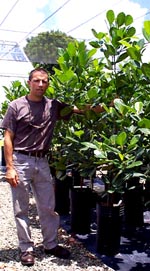
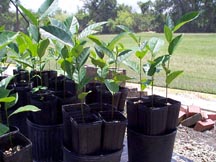
Jackfruit Cultivar Descriptions
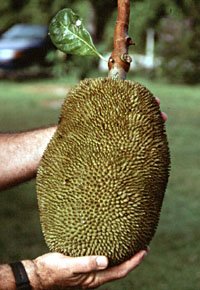
‘Black Gold’ (left) was selected in Queensland, Australia. The tree is vigorous, with a dense and highly manageable canopy. With annual pruning the tree is easily maintained at a height and spread of 2 to 2.5 m (6.5 to 8.1 ft), with consistent, heavy production of 55 to 90 kg (120 to 200 lb) per tree. The fruit are medium-sized, averaging 6.7 kg (14.7 lb), with an edible flesh percentage of 35%. The exterior of the fruit is dark green and has sharp fleshy spines. The spines do not flatten, or “open” upon maturity, making it difficult to judge the proper harvest time and maturity. The deep orange flesh is soft, with a strong, sweet flavor and aroma. The flesh is easily removed from the fruit compared with other cultivars.
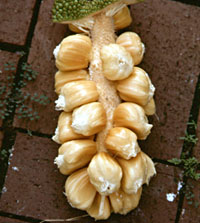
‘Cheena’ (right) is a natural hybrid between jackfruit and champedak. The tree has an open, low and spreading growth habit and can be maintained at a height and spread of 2.5 m (8.1 ft) with annual pruning. ‘Cheena’ consistently produces 50 to 70 kg (110 to 154 lb) per tree. The fruit are long, narrow and uniform in size and shape. The skin is green, with blunt spines that yellow and open slightly upon maturity. Fruit are small, weighing 2.4 kg (5.3 lb) and they have an edible flesh percentage of 33%. The flesh is deep orange, soft and somewhat fibrous, with an excellent flavor. The fruit have an intense, earthy aroma. Fruit preparation time can be as little as 15 minutes, compared to the 1 to 2 hours required for other cultivars.
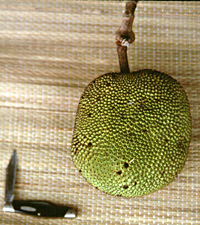
‘Cochin’ (left) was selected in Australia. The tree is low in vigor and forms a sparse, upright and narrow canopy. The tree can be maintained at a height of 2 to 2.5 m (6.5 to 8.1 ft) and a spread of 1.5 m (4.9 ft) with light annual pruning. The fruit are small and smooth in comparison with other cultivars because the spines flatten and open as the fruit matures. Fruit average 1.5 kg (3.3 lb), with 35% edible fruit percentage. During some times of the year, the entire fruit can be eaten, including the “rag”. The flesh is firm and mild, with little latex. The tree often declines following moderate to heavy cropping.
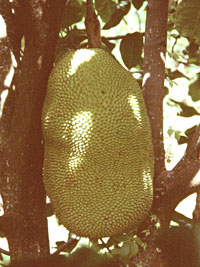
‘Dang Rasimi’ (right) originated in Thailand. The tree is open, spreading and fast growing. It must be pruned annually to maintain a height and spread of 3 to 3.5 m (9.7 to 11.4 ft). The trees are highly productive, yielding 75 to 125 kg (165 to 275 lb) per tree, while maintaining vigorous growth. The fruit are bright green to pale yellow and uniform in shape if thinned to one fruit per fruiting spur. The skin has sharp spines that do not flatten or “open” with maturity. Fruit are medium to large, averaging 8 kg (17.6 lb), with 32% edible flesh percentage. The flesh is deep orange and firm. It has a mild, sweet flavor and a sweet, pleasant aroma. ‘Dang Rasimi’ is one of the most vigorous jackfruit cultivars, and must be annually pruned to maintain size.
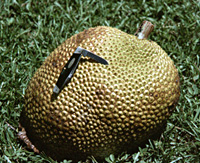
‘Golden Nugget’ (left) was selected in Queensland, Australia. The tree is fast growing, with a distinctive dark green, rounded leaf. It forms a dense, spreading canopy, which is easily maintained at a height and spread of 2 to 2.5 m (6.5 to 8.1 ft). The fruit are small, green and rounded, with sharp, fleshy spines on the skin. The spines flatten to a smooth, golden-yellow upon maturity. The fruit weigh 3.2 kg (7 lb), with an excellent edible flesh percentage of 41%. The deep orange flesh is soft to medium firm depending on fruit ripeness. The flavor is excellent and the flesh has no fiber. ‘Golden Nugget’ fruit will often split open prior to ripening when there are heavy rains. Yields can be maintained at 60 to 80 kg (132 to 176 lb) per tree per year.
‘Golden Pillow’, (not pictured) or ‘Mong Tong’, was introduced to the Americas in the 1980s from Thailand. In its homeland of Thailand it has attained a reputation as a fruit of distinctive beauty and quality. The tree is small and highly manageable with a height and spread of 3 m (10 ft). The fruit average 3.6 to 5.5 kg (8 to 12 lb) with 35 to 40% edible flesh. There are typically 65 to 75 seeds per fruit and little latex. The flesh is thick and crunchy, with a golden color. The flavor is mild and sweet, with no musky aftertaste. This cultivar is noted for precocious fruiting, bearing in the second year after planting.
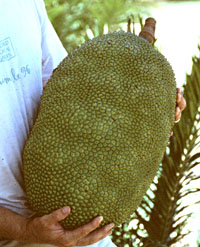
‘J-30' (right) was selected in Malaysia. The tree is vigorous, forming an open, conical canopy. The tree can be maintained at a height and spread of 3 m (9.8 ft) with annual pruning. The production per tree is 50 to 60 kg (110 to 132 lb) per year. Fruit are uniform and hang singly on the major limbs. The fruit are dark green and uniform, with blunt spines on the skin. The fruit average 7.6 kg (16.7 lb), with an edible flesh percentage of 38%. The flesh is deep orange and firm. The flavor is rich and sweet with only a slight aroma to the flesh and fruit.
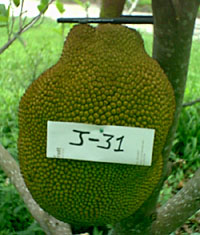
‘J-31' (left) was selected in Malaysia. The tree is moderately vigorous, forming a spreading, open canopy. The tree can be maintained at a height and spread of 2 to 2.5 m (6.5 to 8.1 m). Trees of this size can produce 42 to 60 kg (92 to 132 lb) per year. The fruit are large and irregular in shape with prominent, blunt spines. The weight is 12 kg (26 lb), with an edible flesh percentage of 36%. The flesh is deep yellow and firm with thick walls. The flavor is sweet and rich with a strong, earthy aroma. ‘J-31' will often produce off-season fruit during the fall and winter.
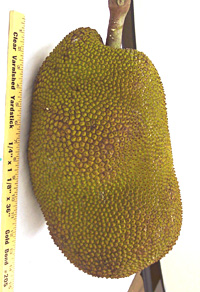
'Mia 1' (right) is an exceptional choice for the homeowner searching for a vigorous, productive and delicious jackfruit. The tree is forgiving in terms of horticulture requirements and will begin to fruit within 2 to 3 years of planting. Fruit can reach 25 to 30 lb with a golden-yellow skin color. The flesh is crisp, sweet and delicious, with little latex. The tree can be maintained at a height and spread of 8 ft.
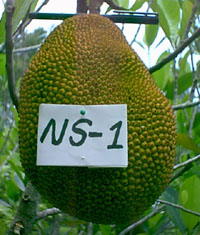
‘NS1' (left) was selected in Malaysia and was among the first superior jackfruit cultivars successfully established in the Western Hemisphere. The tree is of medium vigor, forming a dense, upright canopy, which can be maintained at a height and spread of 2.5 to 3 m (8.1 to 9.8 ft) with moderate annual pruning. Production is heavy, with annual yields of 90 kg (200 lb) or more per tree. The fruit are dark green and blocky, with blunt, flattened spines. The fruit weigh 4.2 kg (9.2 lb), with a flesh percentage of 34%. The spines flatten and open as the fruit ripen. The flesh is dark orange and firm, with a rich and sweet flavor.
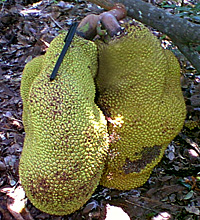
‘Tabouey’ (right) was selected in Indonesia. The tree has small, dark green, rounded leaves and forms an open, rounded canopy. The tree can be maintained with a size and spread of 3 m (9.8 ft) with annual pruning. The tree produces moderate crops of 50 to 70 kg (110 to 154 lb) per tree. The fruit are long, thin and tapered at the stem-end. They are often misshapen and lobed, with a bright yellow color and irregular, blunt spines. The fruit often split prior to harvest. The flesh is firm, pale yellow and has almost no aroma. Its flavor is mild and pleasant.